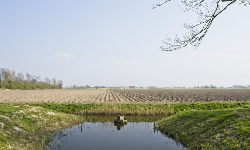Our research centre offers extensive expertise in the optimisation of wastewater treatment processes, environmental analyses, and the rapid ecotoxicological characterisation and biomonitoring of water.
Projects and results.
.jpeg)
Altevas
In this project, the effectiveness of algae technology for the valorisation of effluent streams from greenhouse horticulture was investigated.
.jpeg)
Biomonitoring of aquatic environments in the Amazon using environmental DNA
Traditional biomonitoring of aquatic ecosystems is time-consuming, expensive, and requires extensive taxonomic knowledge. DNA-based monitoring eliminates these drawbacks, but a comprehensive database of DNA sequences for all target species is needed. In this project, such a database was developed.
.jpeg)
VLIR-UOS Network Ecuador: Biodiversity
The goal of this project is to help shape professionals and specialists in Ecuadorian biodiversity and water resources.
.jpeg)
DNA-based monitoring for assessing the effect of invasive species on aquatic communities in the Amazon basin of Ecuador
In this project, a DNA-based monitoring system was developed to detect invasive fish species and their effects on aquatic communities in the Ecuadorian Amazon basin at an early stage. This was achieved by optimizing the nanopore Next-Generation Sequencing (NGS) technique (MinION), enabling biomonitoring of tropical aquatic environments.
.jpeg)
Move-it-lab
The revolutionary combination of a mobile, on-site wastewater treatment unit and a high-tech laboratory module. Here, physicochemical water analyses are combined with advanced microscopic sludge analyses and modern molecular identification technology.
(1).png)
Developing new genetic tools for bio assessment of aquatic ecosystems in Europe
The goal of this COST action was to bring together a group of researchers from various disciplines to identify genomic tools and new ecogenomic indices that form the basis for routine application in biodiversity assessments of European water bodies.
.jpeg)
Phage4water
Phage therapy for improving sludge quality: towards healthier and more energy-efficient water treatment.
(1).png)
WIJ-water
With this project, we aim to make the polder areas in North-West Flanders, East Flanders, and Zeeland more climate-resilient by focusing on (1) cross-border water management and (2) large-scale above-ground freshwater buffering in existing canals (Schipdonk Canal, Leopold Canal, Damse Vaart, Plassendaele, Nieuwpoort).

Cross-border cooperation for actions supporting water resources
CARE+ focuses on reducing water pollution caused by intensive agriculture in border regions. Pesticides, nitrates, and phosphorus threaten water quality, especially during droughts and floods, which are exacerbated by climate change. Despite existing solutions, they remain small-scale. The project aims to strategically apply these techniques in four river basins, with the involvement and support of farmers.
The environmental technology lab at HOGENT has expertise in process optimisation for wastewater treatment, both physicochemically and biologically, as well as in rapid ecotoxicological characterisation of water and environmental analyses.
Get to know our experts.
(1).png)
Bjorge Decostere
Treatment, valorisation, and reuse of industrial wastewater, microalgae systems, biokinetic modelling, respirometry

Christine Van der heyden
Water quality, optimisation of water treatment, aquatic biomonitoring, environmental DNA, international collaborations (mainly Ecuador)
.png)
(1).png)

(1).png)